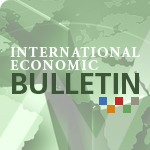Helped by monetary and fiscal stimulus, as well as by the need to rebuild inventories, various production indicators continued to show improvement last week. However, final private demand and consumer confidence continued to register weakness, suggesting that while world economic activity is stabilizing, it is not yet firmly on a path of sustained recovery.
Although there has been a marked easing of credit conditions and stock markets are rallying, low levels of activity (e.g. industrial production in May is down over last year by 13.6 percent in the U.S., 29.5 percent in Japan, and 17 percent in the Euro Area), and high and rising unemployment, signal continued strain on the balance sheets of many households and firms. This is reflected in rising loan default rates. The consensus forecast and the financial markets are betting on a sustained recovery beginning in the third or fourth quarter of this year, and this is probably on balance the right bet. However, so long as corporate and household balance sheets remain under such great strain, the risk of a failed take-off, or of a take-off followed by a relapse, remain considerable.
Appropriately, signals from the Fed and other central banks convey that monetary policy will remain supportive in the foreseeable future, especially given low inflation readings. Furthermore, much of the effect of fiscal stimulus still lies ahead.
The Real Economy: Production stabilizing but final demand remains weak
- The U.S housing market showed some signs of recovery last week, with housing prices experiencing the smallest decline in 10 months; prices ended the month of May 5.6 percent lower than they were the same time last year, but having risen 0.9 percent since the month before.
- South Korea showing its fastest growth GDP in six years, with a 2.3 percent (q/q) and 9.5 percent (y/y) increase in the second quarter. Japan’s trade surplus increased by 70.5 percent (m/m) and 388.5 percent (y/y) in May.
- Surveys of business activity in the Eurozone showed an improvement in July across both manufacturing and service sectors. The Purchasing Managers’ Index (PMI) for Euro Zone increased 8.0 percent (m/m) to 46 in July, and the German’s PMI jumped 4 points to 48.9.
- Yet despite these improvements, the Michigan/Reuters Consumer Sentiment Index declined by 6.8 percent (m/m) in July, having reached a ten month high in June.
Economic Policy: Still stimulative
- The U.S. Federal Reserve, Bank of Canada, the Bank of Japan and the Reserve Bank of Australia all released assessments suggesting the worst of the economic downturn is over but also signaled that policy interest rates would stay low in the foreseeable future.
- In his semi-annual congressional testimony, Federal Reserve Chairman, Ben Bernanke noted that while the worst housing downturn in eighty years appears to be moderating, the Fed still expects the economy to remain vulnerable to shocks.
- The central bank of Canada maintained its overnight rate at 0.25 percent. It also reiterated its commitment to keep rates on hold until the end of second quarter of 2010, conditional on the inflation outlook.
- Brazil’s central bank lowered its key lending rate by 50 basis points to a record 8.75 percent. The bank had cut the rate by at least 100 basis points in all four previous policy meetings of 2009.
Financial Markets: Credit conditions continuing to ease
- In the credit market, the 3 months LIBOR-OIS spread -- the premium over expected central bank interest rates that commercial banks charge each other, which serves as a gauge of banks’ reluctance to lend -- continued its decline to 0.31 percent, 0.69 basis points below its value from the previous week and 6.25 basis points below its value from a month ago.
- Global equity markets rallied sharply last week, buoyed by robust corporate earnings and signs that the housing market is starting to stabilize. The U.S.’ Dow Jones and NASDAQ rose by 4.0 percent and 4.2 percent, respectively. The UK’s FTSE 100 and Germany’s DAX gained 4.3 percent and 6.4 percent, respectively, while Japan’s Nikkei 225 was up modestly by 5.8 percent. The MSCI World Index and the MSCI Emerging Markets Index last week added to the previous week’s gains to take the year-to-date returns to 11.7 percent and a massive 45.3 percent, respectively.
- Major commodities have experienced price increases, with oil prices closing last week at $68.05, well above the month’s low of $58.78, while gold and silver have increased 4.4 percent and 9.7 percent respectively from the first week of July.
- Major sovereign bond markets closed the week higher. The yield on U.S.10-year treasury bills rose to 3.67 percent, up 3 basis points over the week. In Europe, the UK 10-year bond yield was up 15 basis points to 3.96 percent. Emerging markets bond issuance has risen to record levels recently as investors switched to these bonds because of attractive yields. Yields on emerging market sovereign bonds, measured by JPMorgan's EMBI Index, are nearly 2 percentage points higher than those on single A-rated U.S. corporate bonds.





